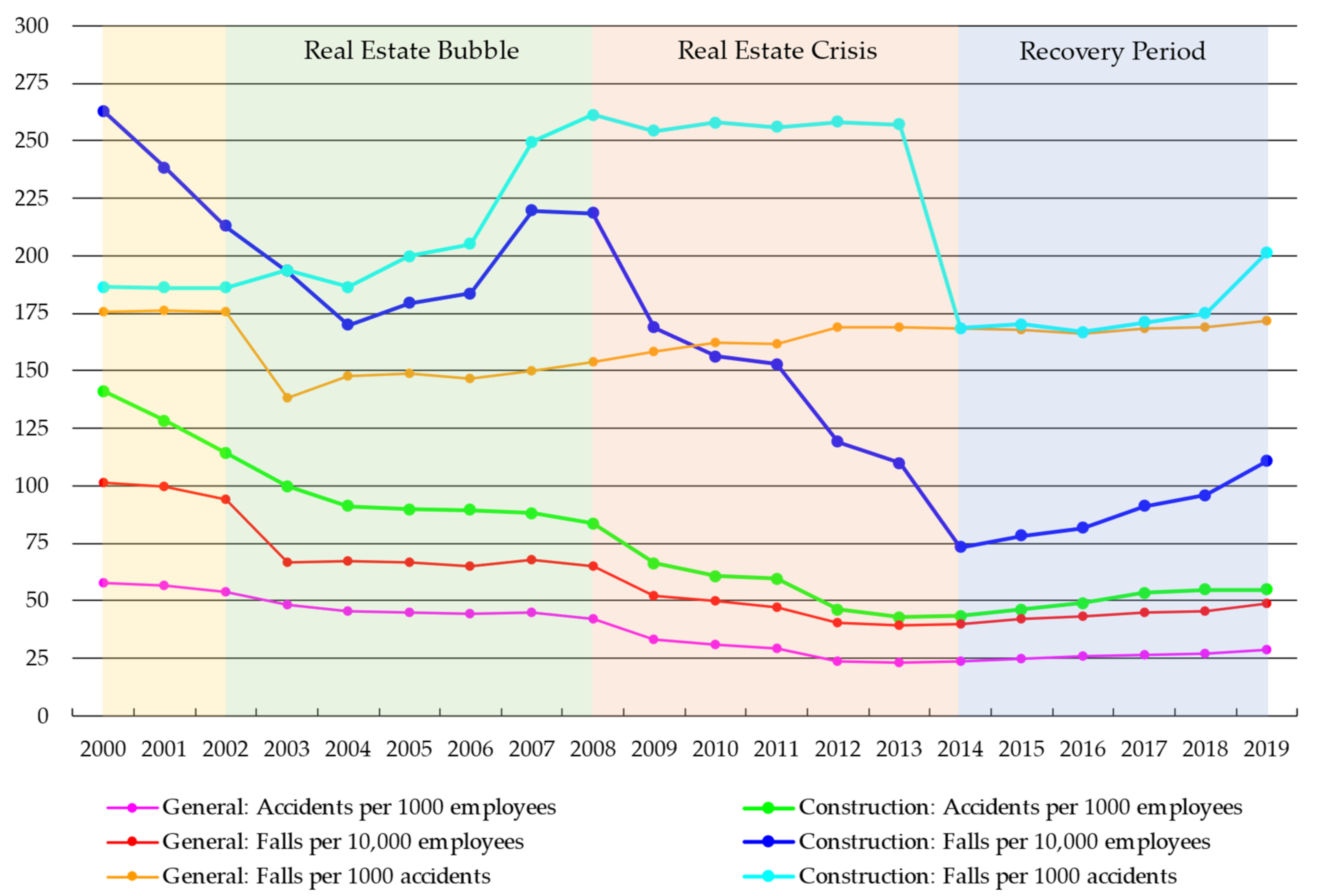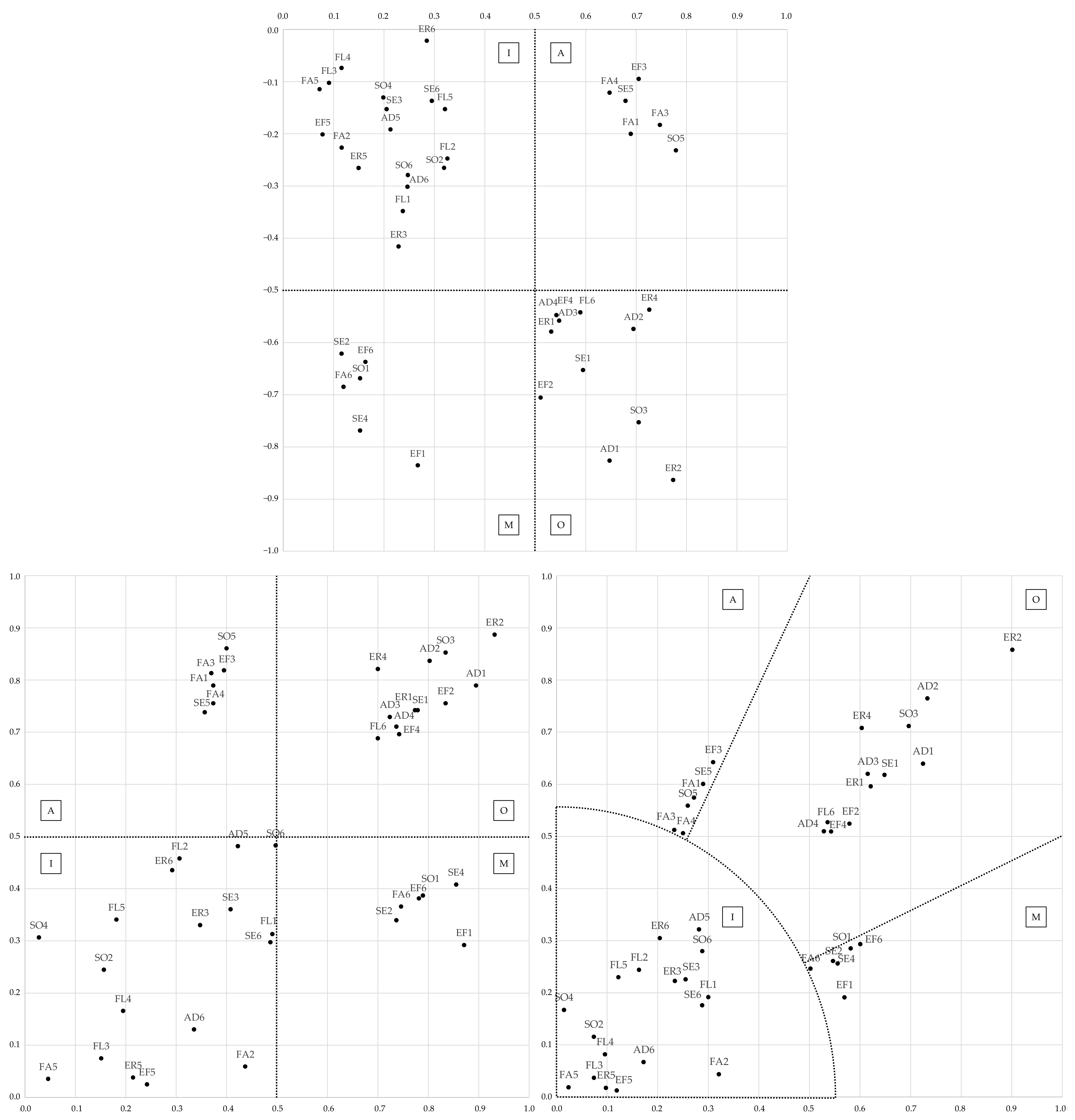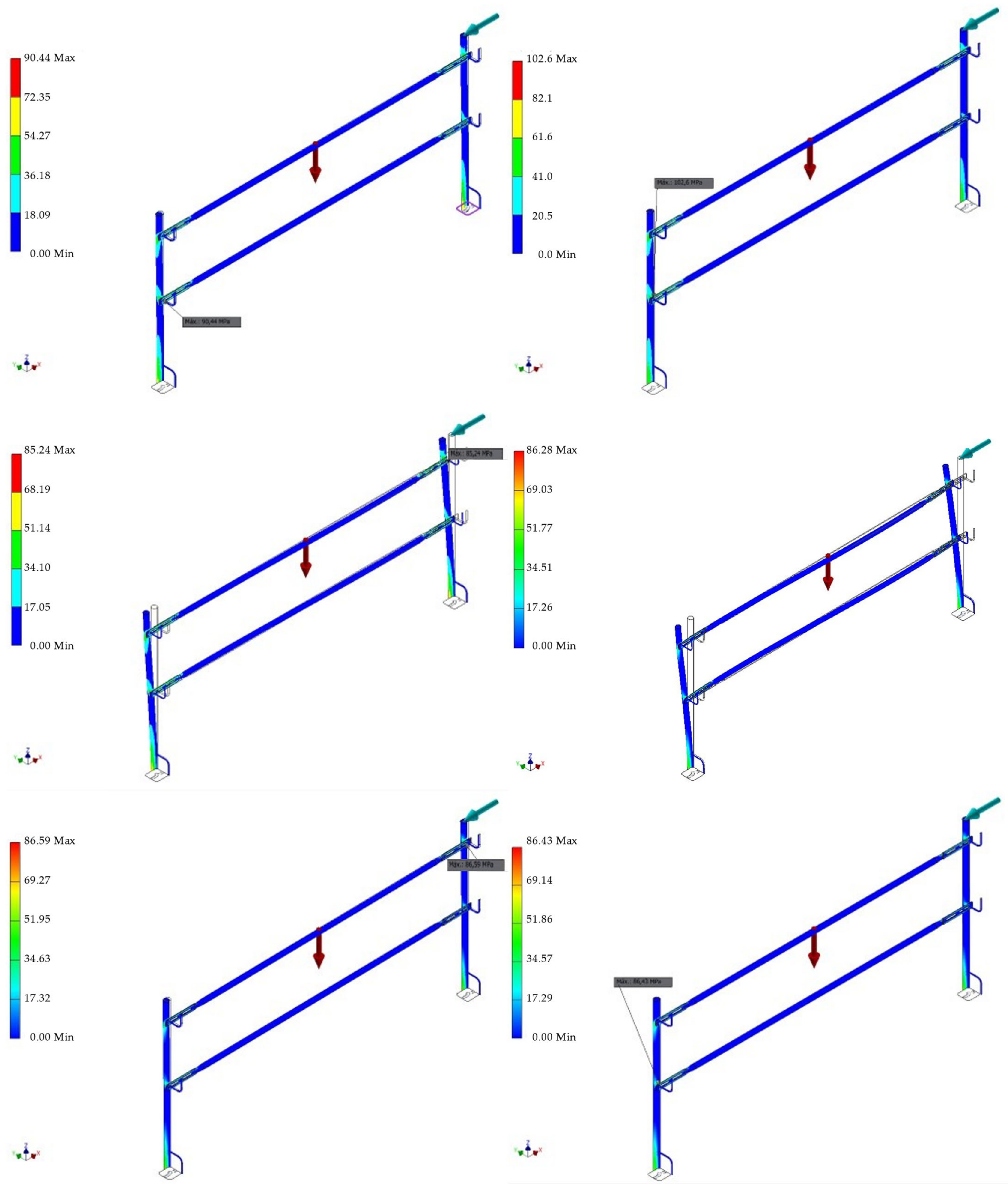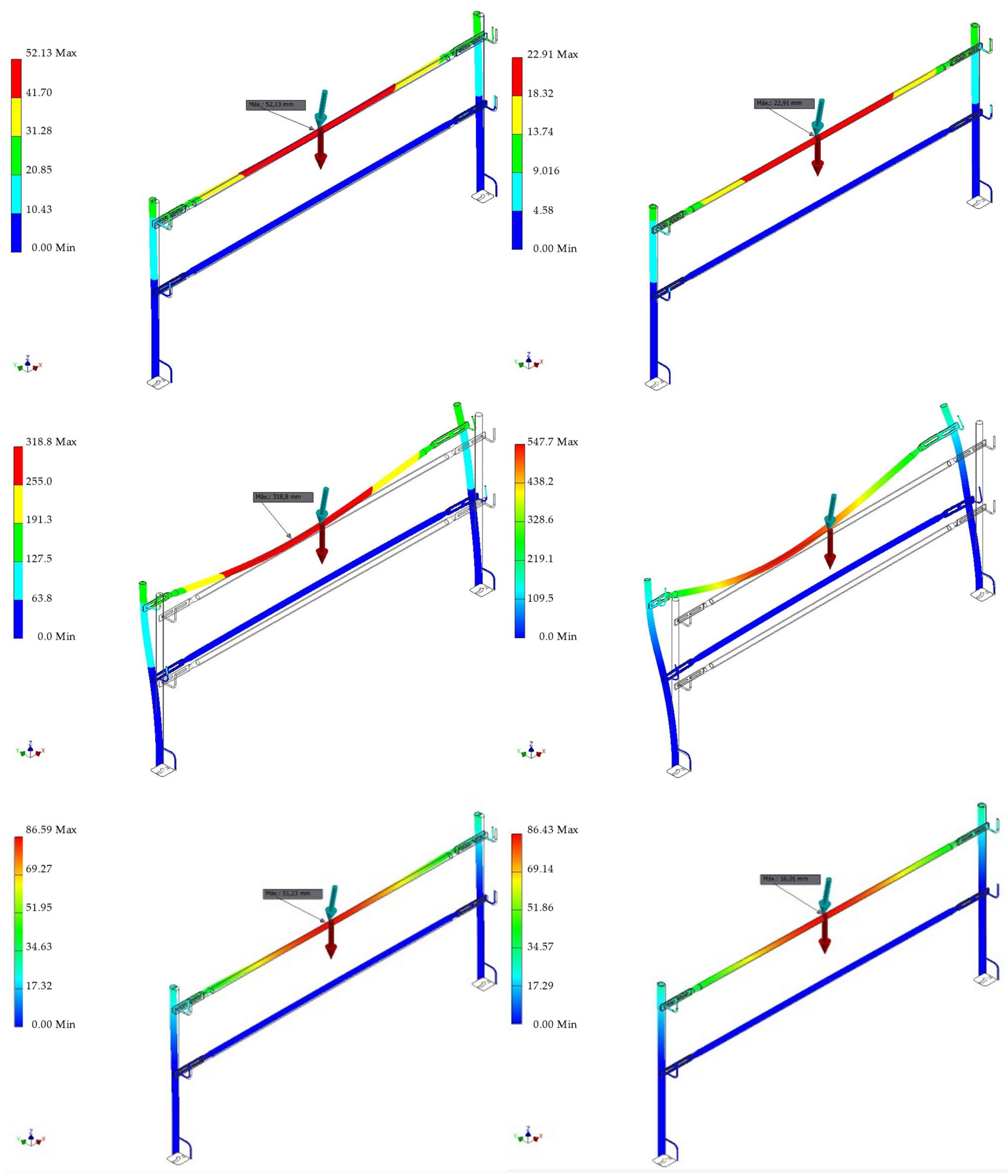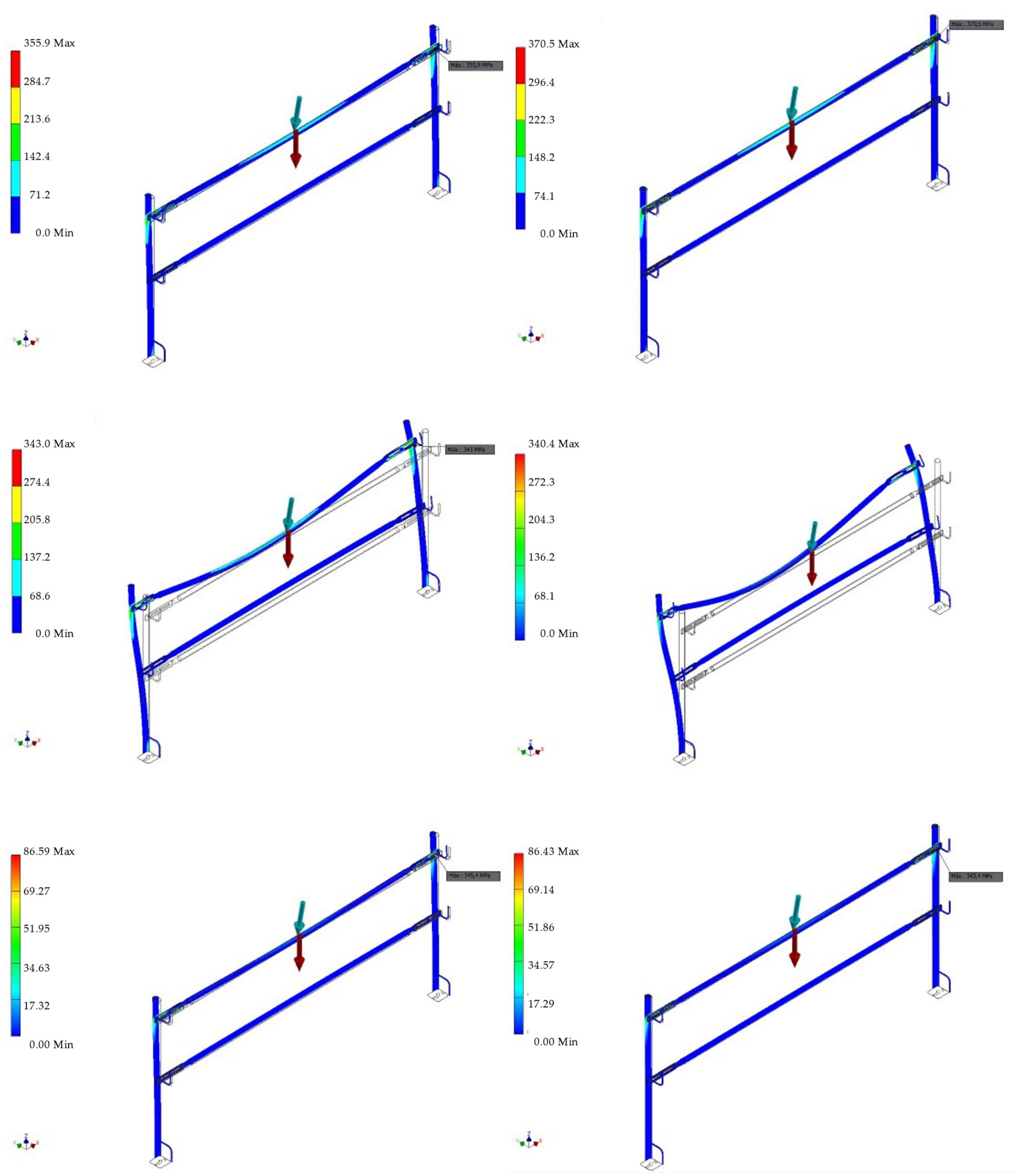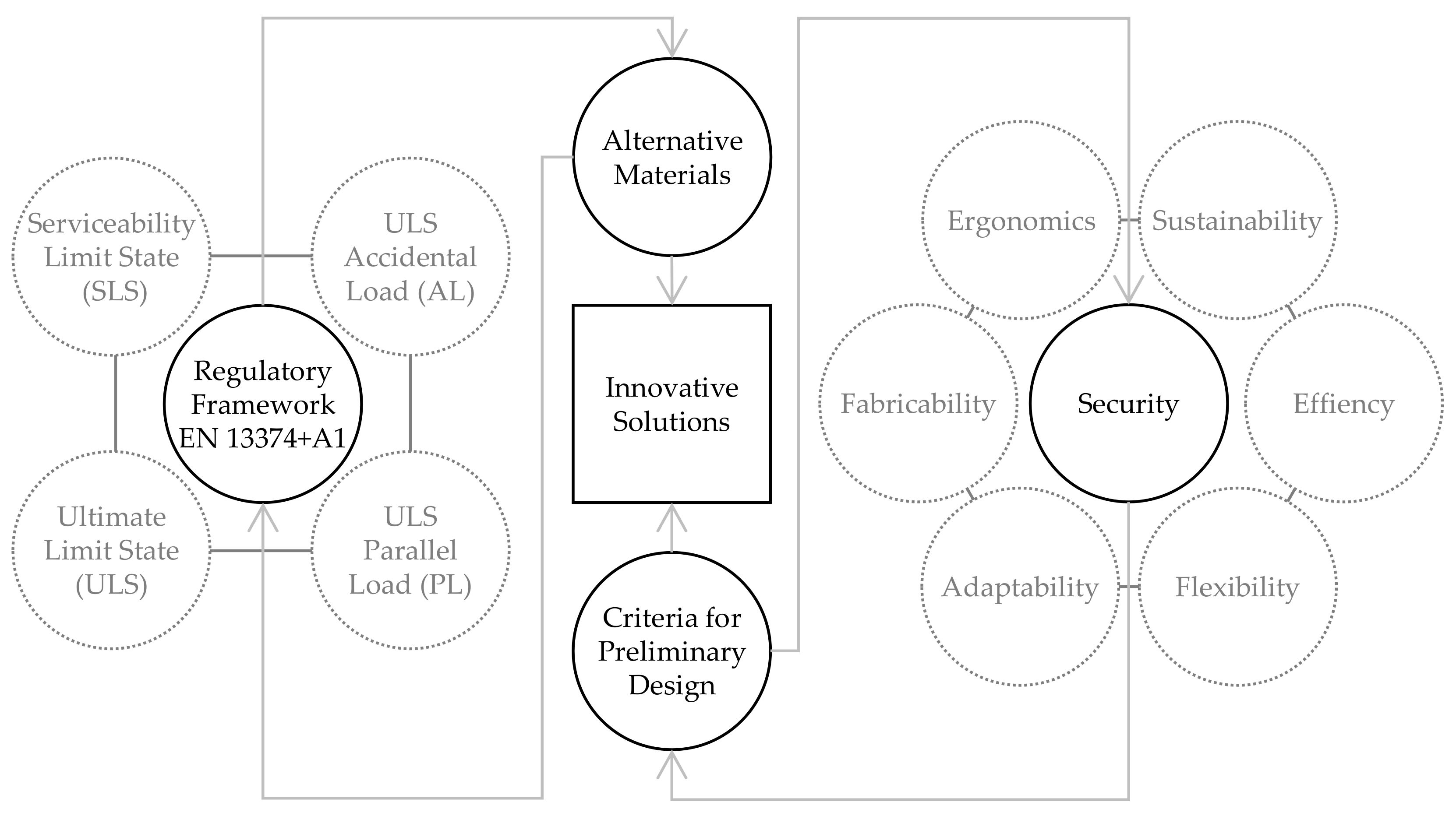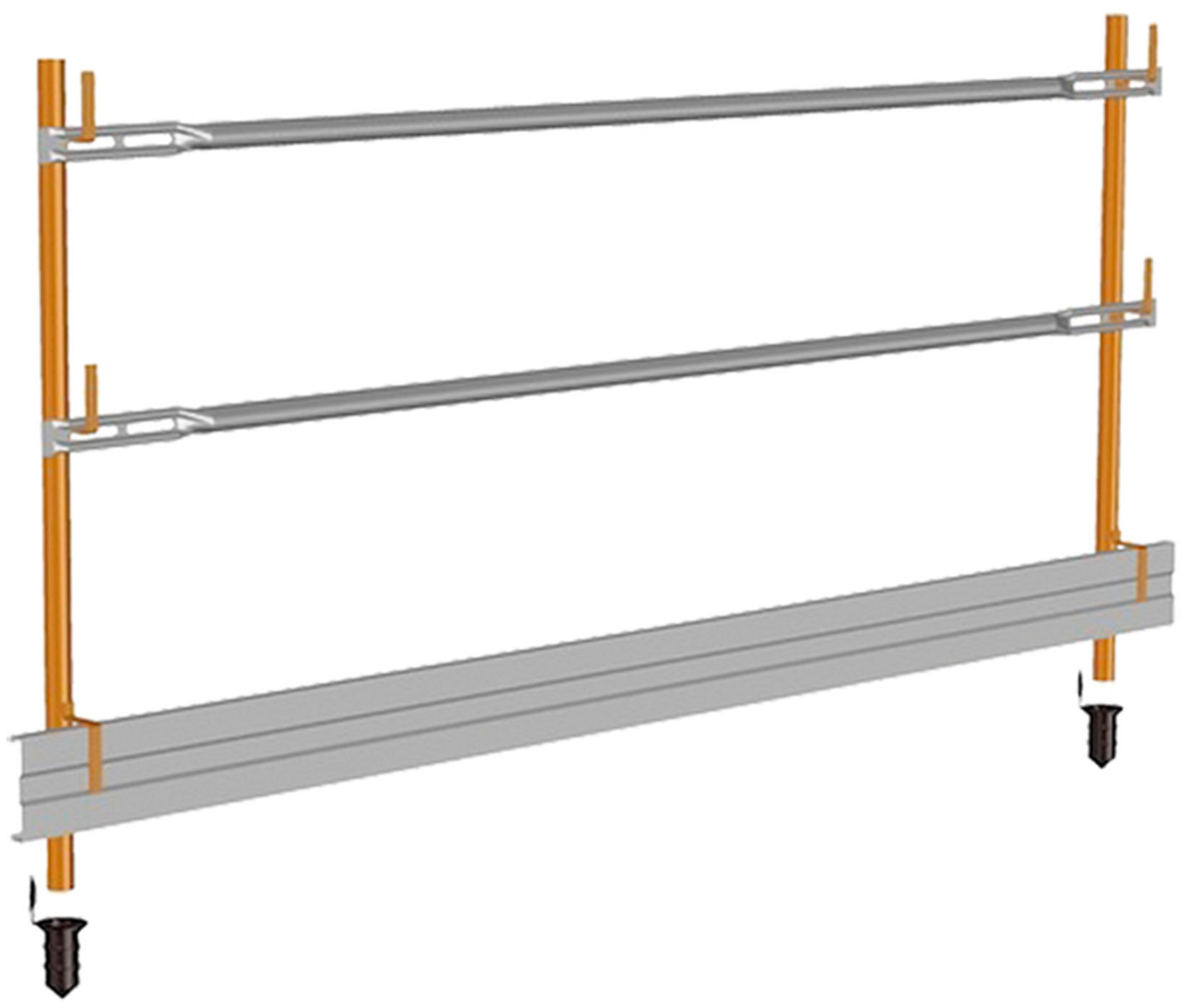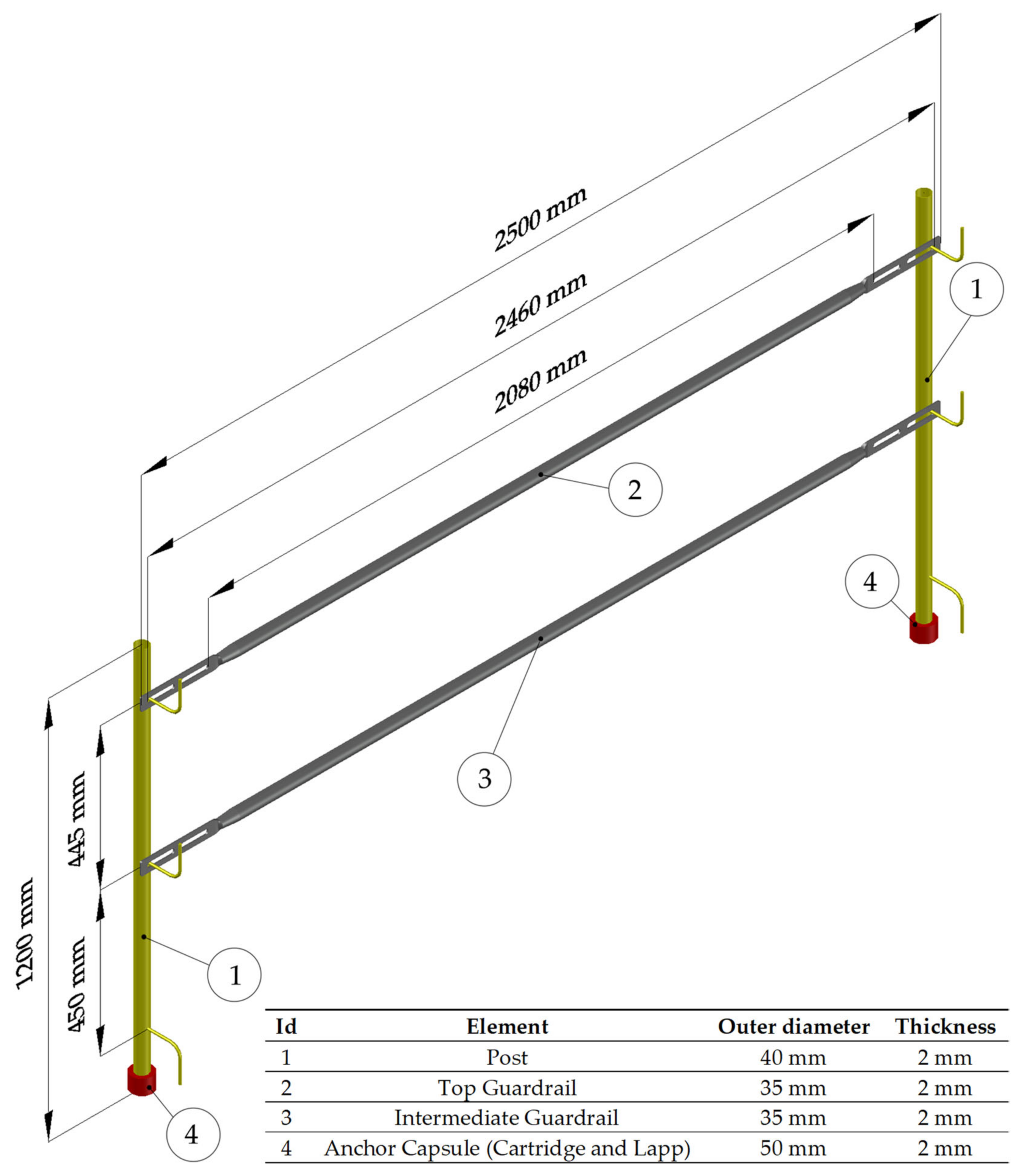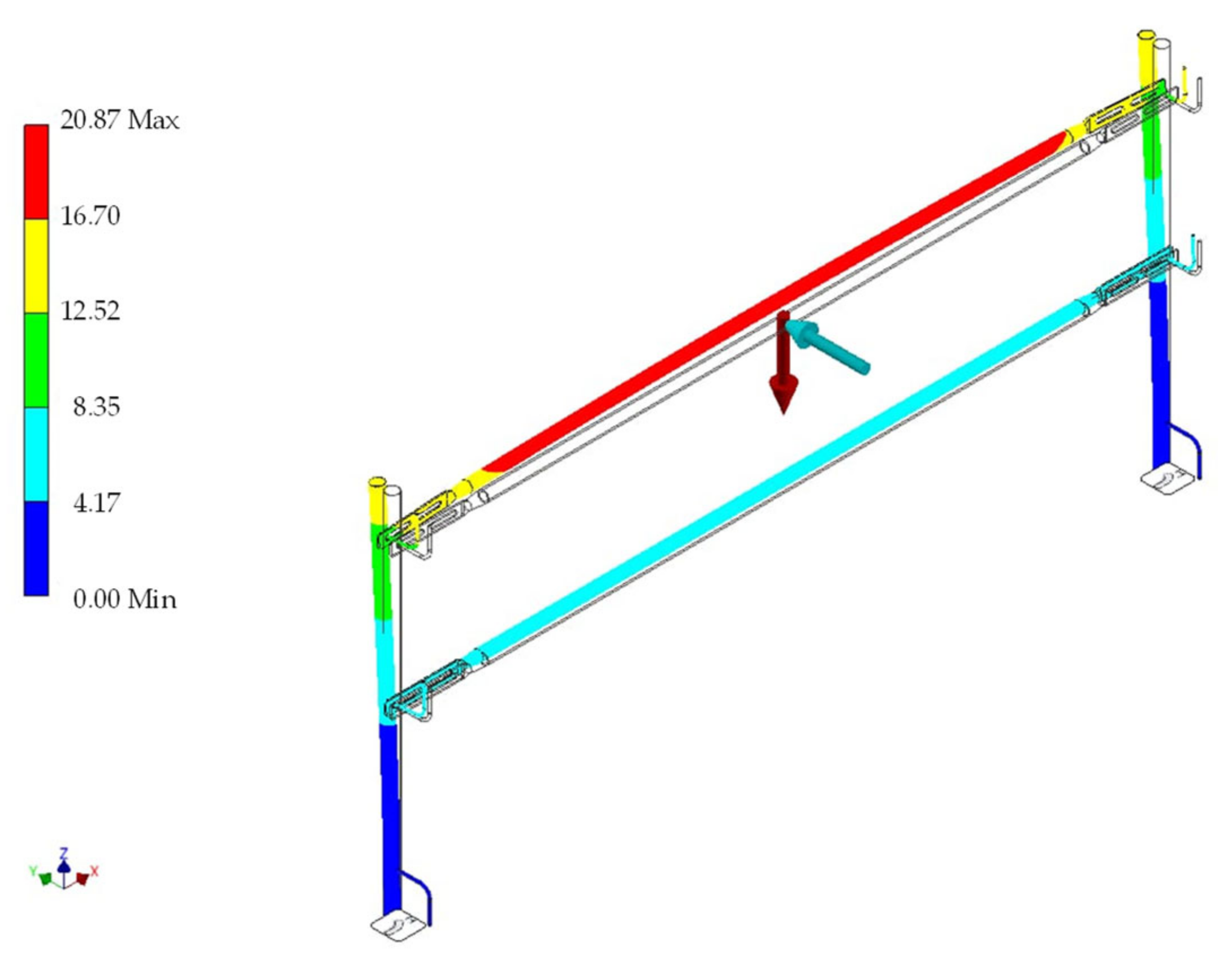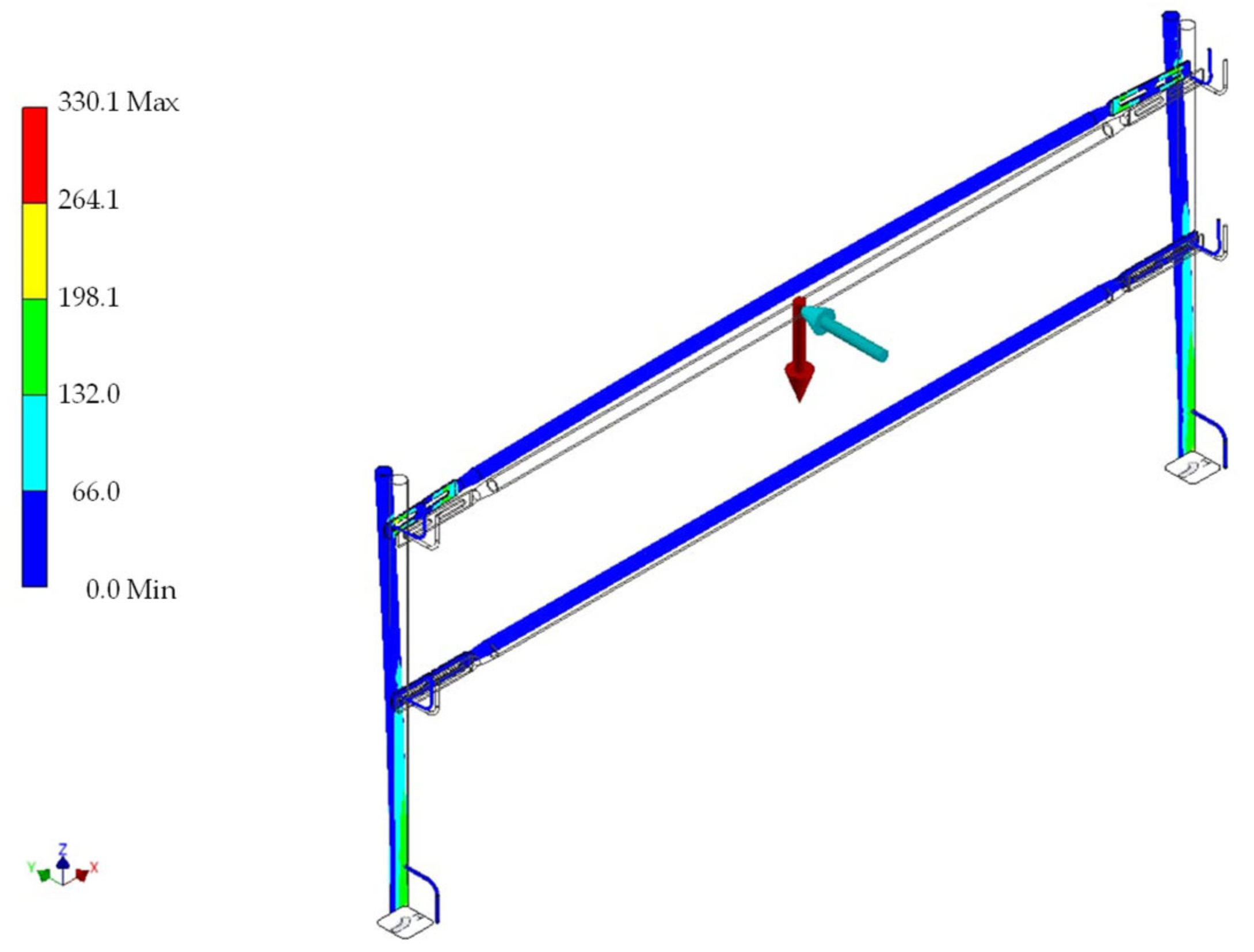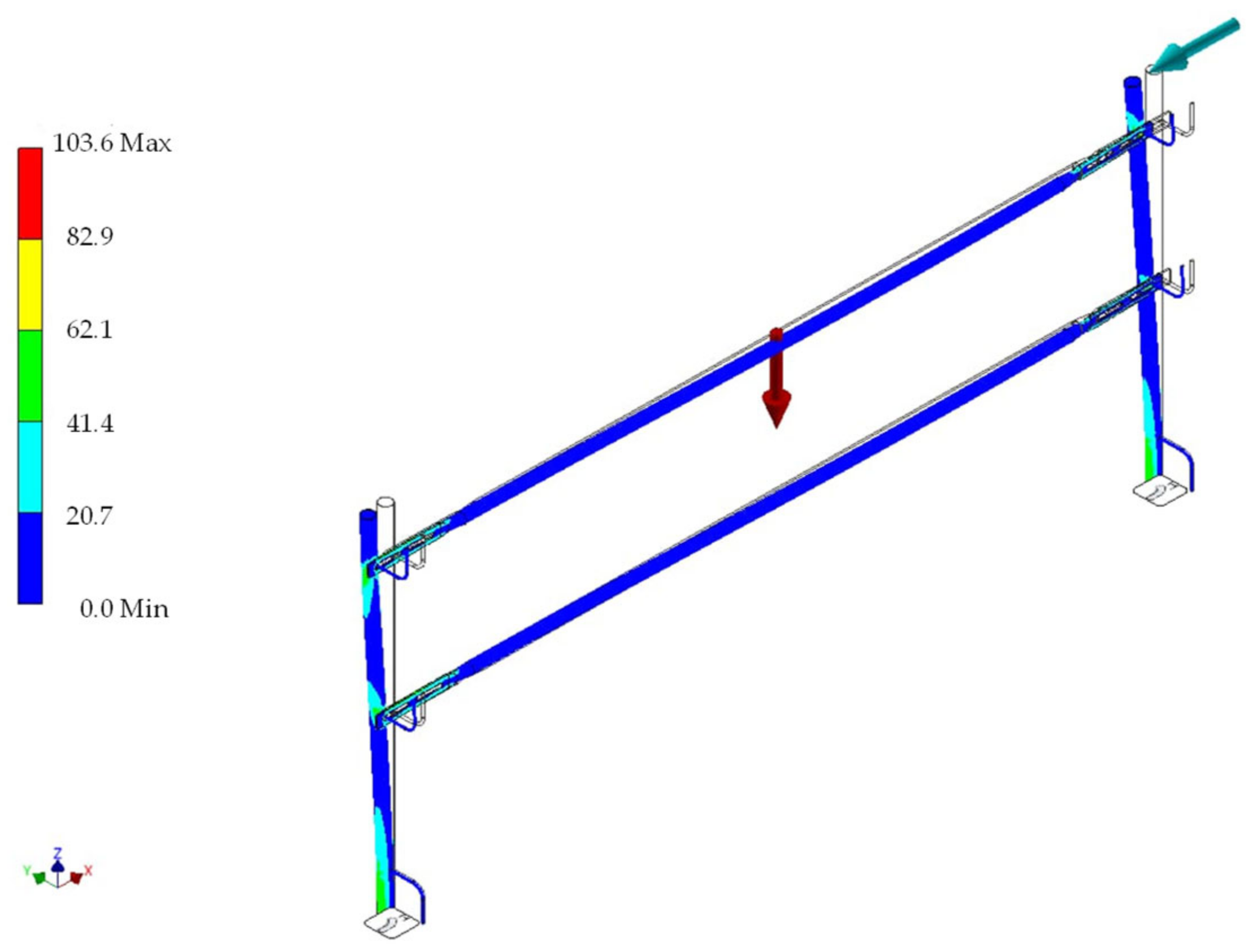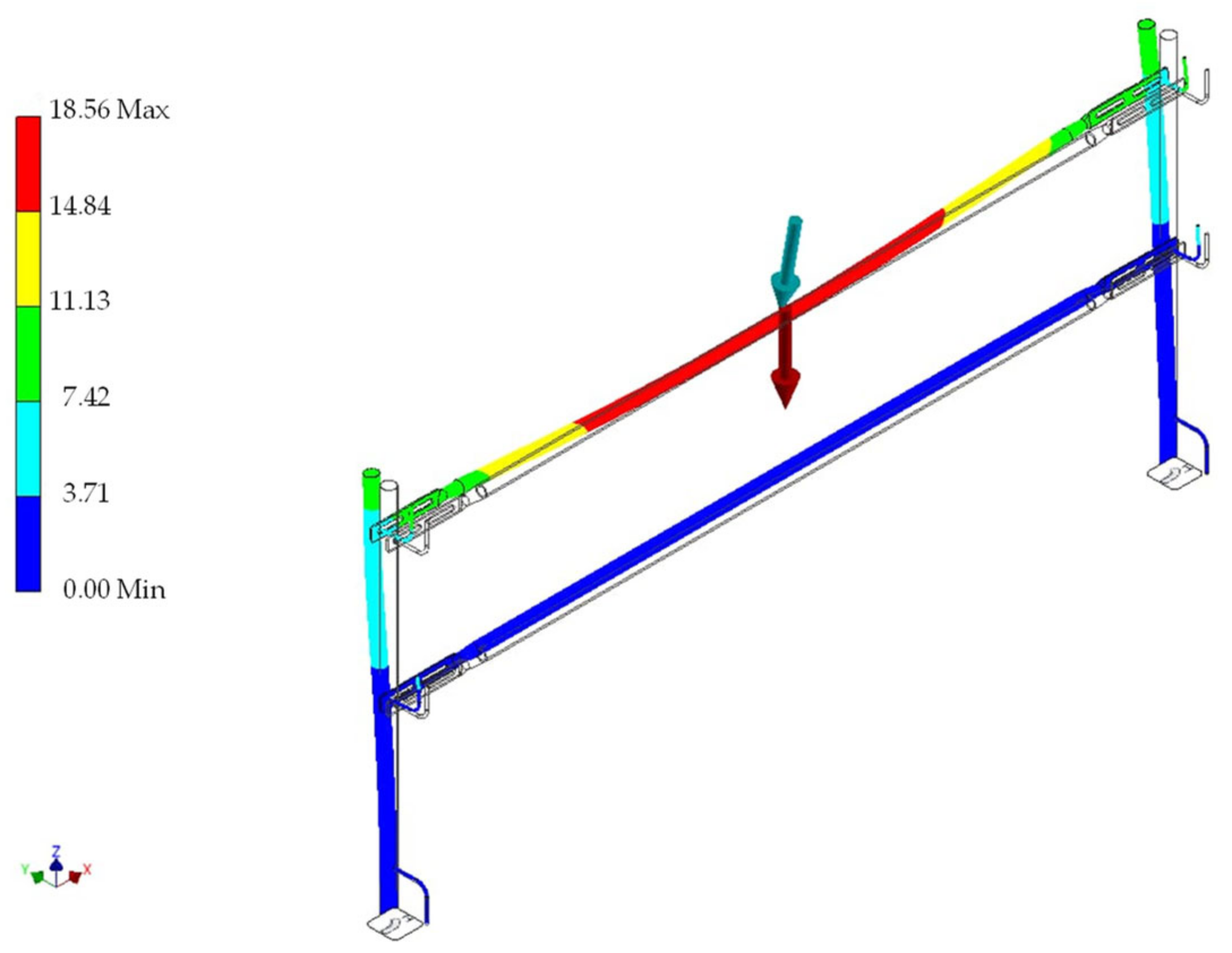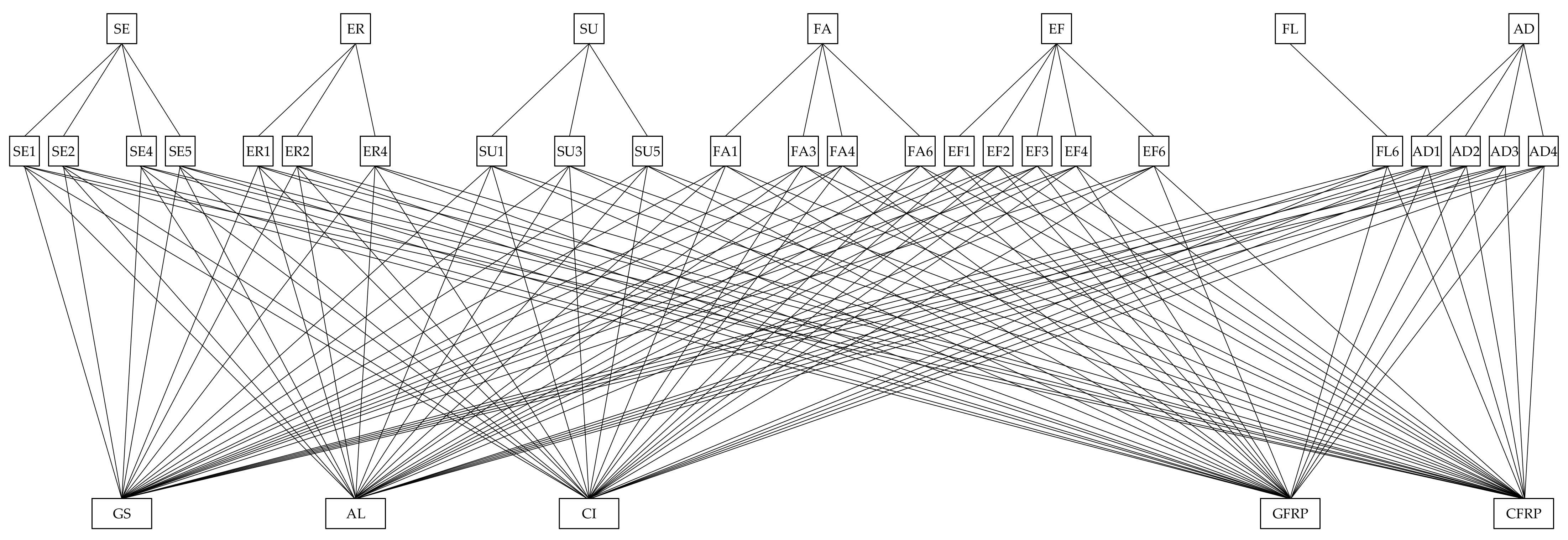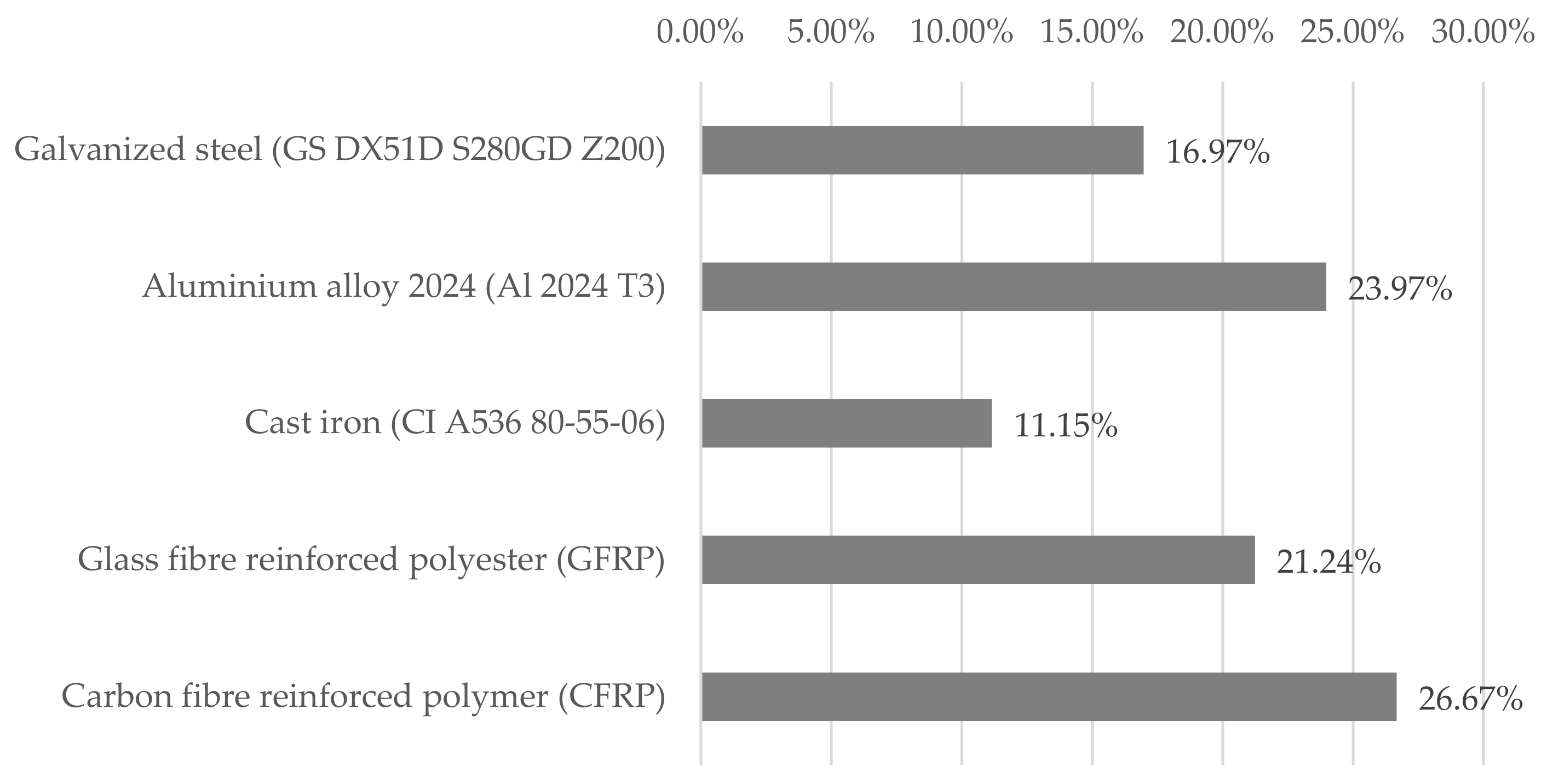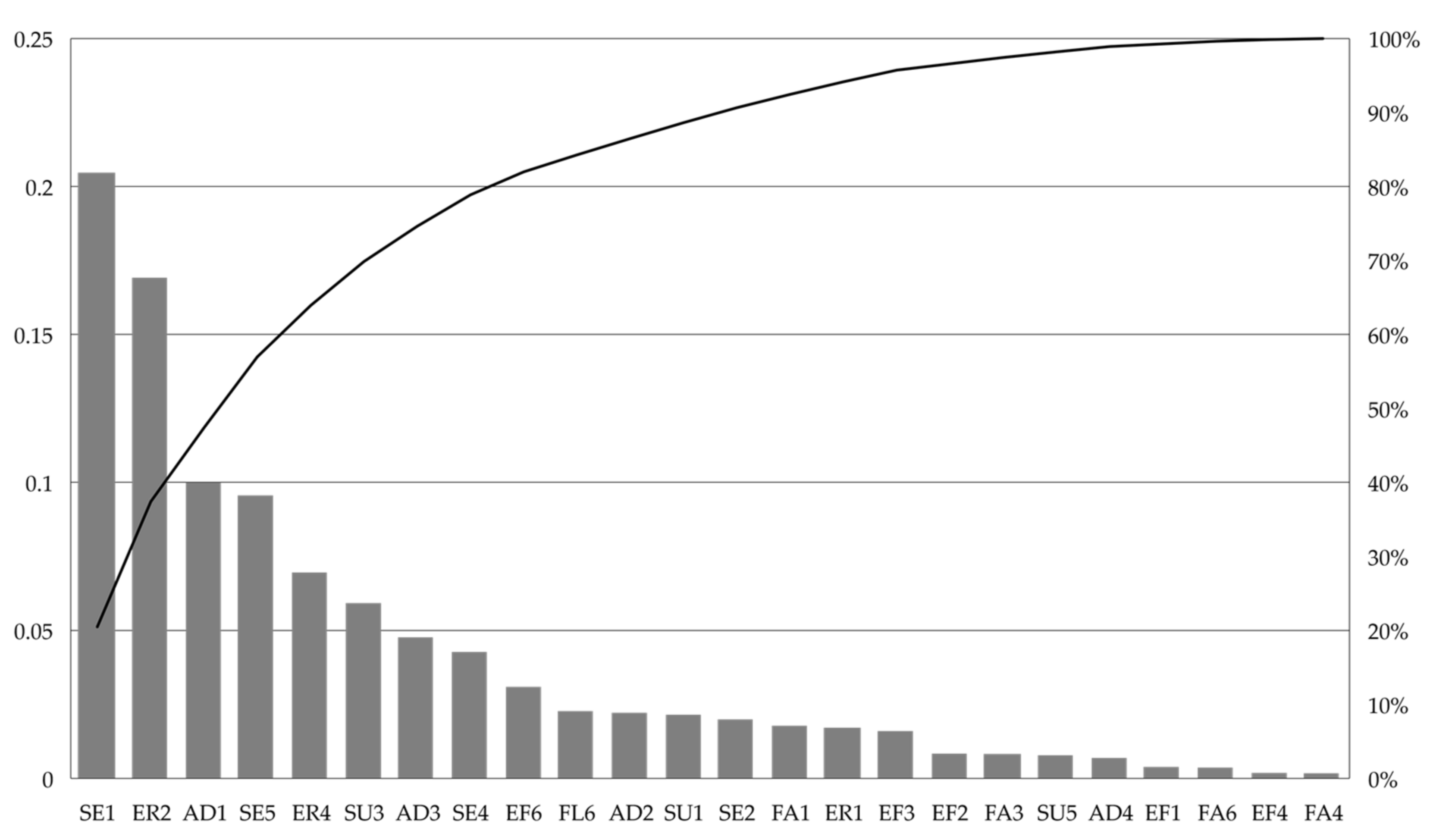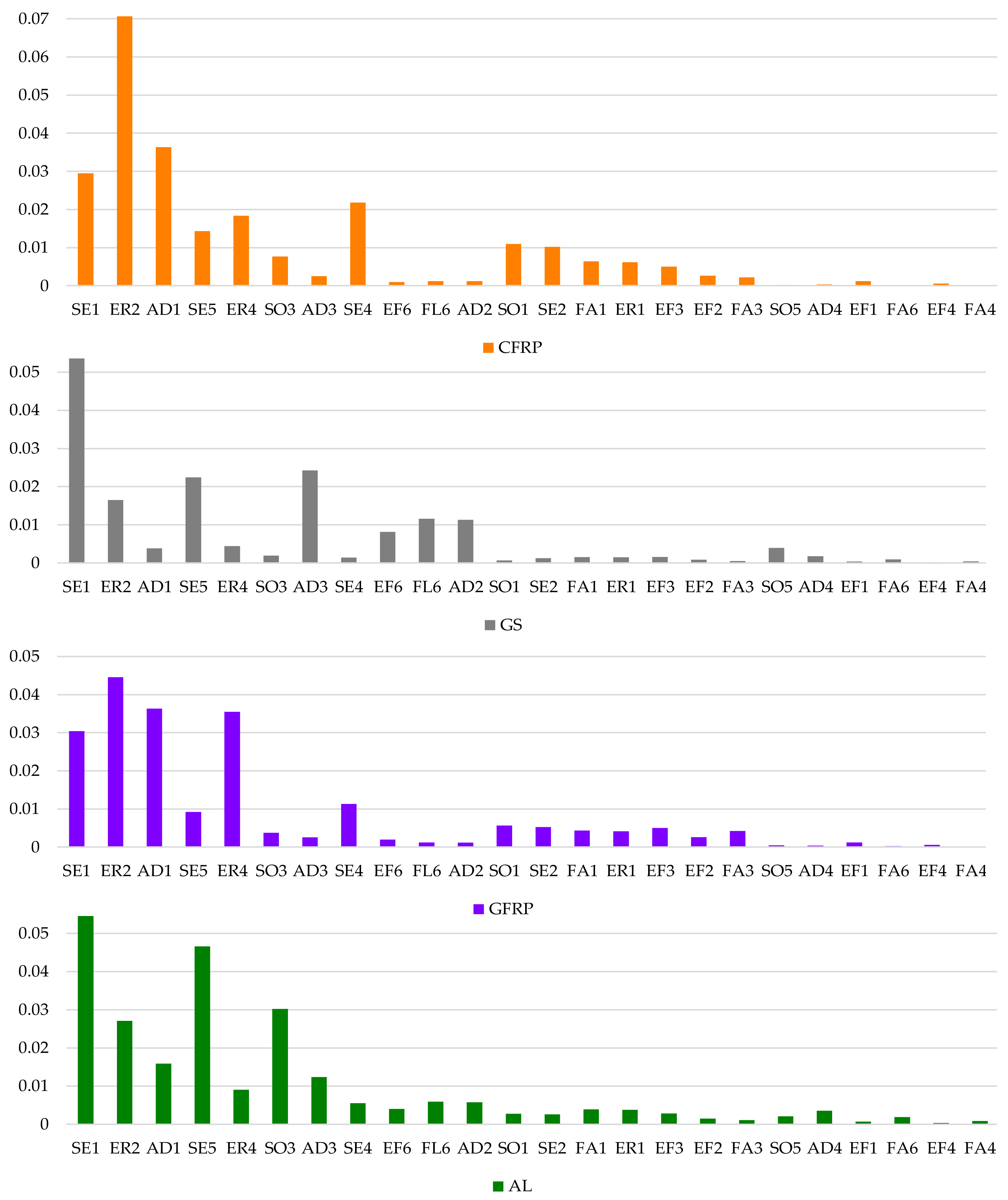1. Introduction
Construction has been essential for human survival throughout history. The archaeological, architectural and civil remains that exist all over the world give rise to the unsettling question of the working conditions that the labourers endured. We must ask ourselves, from what moment did humanity opt for the defence of life in the workplace [
1]? Some renowned authors have ventured to formulate their own theories, fixing that moment to the publication of a text by Strabo [
2]. However, even when taking into account the evolution of technical means and the specialisation of today’s workforce, safety conditions may not differ very much from those that existed in the past [
3]. Any theory about the evolution of work and its conditions points to the fact that the concept of “safety” must have had different meanings throughout history. However, despite these changing conditions and the context of each era, construction has not slowed down.
Among the most popular topics in construction safety, accidents resulting from falls from height have garnered the attention of researchers over recent years [
4], with numerous studies reflecting concern in this field [
5,
6,
7]. Falls from height are the most frequent cause of injuries and deaths. The most common sources are: scaffolding or platforms without railings, workers not wearing safety harnesses correctly, unsound roofs, deficiencies in maintenance, the placement and securing of ladders, etc. These accidents have enormous consequences for people, business owners and society. Priority should, therefore, be given to measures that eliminate or reduce the risk at source and provide collective protection [
8] over individual protection [
9].
Domino theory [
10], pioneering in the study of the causes of accidents (context, human error, unsafe conditions, accident, injury), indicates that 88% of accidents are caused by unsafe acts or behaviours, 10% are due to unsafe working conditions and the remaining 2% stem from unforeseeable causes. In this regard, several authors have pointed out that 90% of work accidents occur as a result of unsafe acts on the part of workers [
11,
12,
13], confirming hypotheses put forward 60 years ago. However, other authors added that unsafe behaviours carried out by workers persist because they are often naturally reinforced [
14]. For example, it may be difficult to properly use collective protection equipment with the auxiliary means available for carrying out tasks, as in the case of the outer railings on scaffolding trestles (sawhorses) [
15].
Many unsafe behaviours of workers are reinforced positively (increased productivity) or negatively (reduced time and effort), which contributes to the increased likelihood that they will perform these same behaviours again in similar circumstances. In this sense, it is clear why operators engage in unsafe work behaviours [
16], and the issue is simultaneously tackled by means of accident causality theories and human error theories [
17]. Although workers are aware of the dangers associated with not wearing a safety harness or not having protective equipment, many forget or purposely do not use them when working at heights [
18], so falls from height remain the main contributors to injuries and deaths on construction sites.
When analysing the time involved in assembling a security system for very small or one-off jobs, the arguments are the same, since there are no protection elements on the market that adapt to the specific circumstances of these small jobs, which, in many cases, only last a few hours or even minutes. Likewise, there are frequent complaints from operators that protective equipment, specifically, personal protective equipment (PPE), tends to hinder their movements, restricting their freedom and preventing or complicating the performance of specific tasks that take up very little time. This context shows that, despite having collective and/or individual protections, these complaints are not handled adequately. Therefore, to avoid this type of accident, and regardless of the behaviour related to the human factor, it is necessary to look for new methods that contribute to improving safety and health and reducing or eliminating subjectivity in production processes [
19].
One of the most important measures to prevent falls from height on construction sites is the use of temporary edge protection systems (TEPS) [
20,
21]. Although studies of TEPS have been carried out from the point of view of the legal regulatory framework, based on compliance with a series of structural requirements [
22], on the identification and evaluation of new needs, on innovation [
23] or on the incorporation of new solutions and/or materials [
24], no studies have been found that bring together all these considerations to address the innovative design, development and prototyping of new TEPS.
The rest of this paper is structured as follows.
Section 2 presents the purpose of the research.
Section 3 describes the methods selected to be followed based on the design science research (DSR) methodology (analysis of the current scenario by literature review, study of the behaviour of current collective protections by finite-element calculation, ranking of the attributes to be considered using the Kano model and proposal for the requirements of a preliminary design by means of an analytic hierarchy process (AHP)).
Section 4 presents the results obtained.
Section 5 discusses the findings. Finally, in
Section 6, the main conclusions are presented.
3. Methodology
The methodology followed is the DSR methodology, the objective of which is to develop innovative solutions to solve real problems while aiming to advance theoretical knowledge [
25] by generating knowledge through the development of an innovative tool that solves a practical problem [
26]. DSR starts with a descriptive phase for a deep understanding of the problem, and this gives way to a prescriptive phase [
27]. DSR is a systematic yet flexible methodology aimed at improving engineering practices through iterative analysis, design, development and implementation based on collaboration between researchers and practitioners in real-world environments and leading to context-sensitive design theories and principles [
28].
The practical problem addressed by this study is the selection of a series of alternative materials that can be used to lay the foundations for an innovative design of TEPS. It also considers the needs to be satisfied and the requirements to be met, listed, prioritised and hierarchised. This methodology has been successfully tested in the field [
29,
30]. This study, based on a review of the literature published on the subject and information obtained in the field (thanks to the authors’ professional experience in this field), analyses the needs and requirements that TEPS must meet through the Kano model [
31], successfully tested in this field [
32,
33], in order to understand the reasons why workers in the construction sector fall from heights. Different materials are studied for the preliminary design of TEPS in relation to safety, efficiency and flexibility during their design and use as a minimum. The AHP tool [
34,
35] is used to hierarchise these alternative materials and recommend possible changes to accommodate aspects of sustainability, ergonomics, adaptability and manufacturability, among others. This combination of the Kano model with the AHP tool has been successfully tested both in product design in general [
36,
37] and specifically in terms of safety [
38,
39].
The Kano model is used to measure the effectiveness of products based on the identification of their requirements. The method classifies design preferences into five categories using a questionnaire that includes functional and dysfunctional questions. On the one hand, it considers the level of performance of the product and, on the other hand, the level of satisfaction of customers and/or users, which makes it possible to evaluate requirements by classifying them into 5 groups: mandatory, attractive, one dimensional, indifferent and reverse [
40]. In this context, a requirement is considered mandatory if its absence causes dissatisfaction, even if its presence is taken for granted, and, therefore, its inclusion is not especially valued, while it is called attractive if customers and/or users value it when it is present, even if they do not notice its absence. Likewise, a requirement is called one dimensional if it increases satisfaction in proportion to the increase in its functionality and indifferent if customers and/or users are not interested or, secondly, if it has neutral and/or low impact. Finally, if the requirement undermines the functionality of the product and/or causes dissatisfaction, it is called reverse [
41].
The AHP tool responds to the general approach of multi-criteria analysis for decision making. It is a discrete, multi-criteria decision-making method in which the problem to be solved is modelled from a set of alternatives and a series of decision criteria that, at times, can be conflicting [
42]. The AHP is applied by building hierarchical structures in which the first hierarchical level consists of establishing an objective, the next hierarchical level, the decision criteria and, finally, the alternatives. For hierarchical levels, pairwise comparisons are made, either by assigning an absolute scale numerical value from 1 to 9 or by assigning a natural measurement scale value [
43]. These comparisons result in dominance matrices. To apply AHP, it is necessary to analyse the alternatives that respond to the previously defined objectives. Next, the decision criteria must be selected. Then, those criteria are considered. Subsequently, the alternatives must be evaluated (after the level of satisfaction of each criterion). Once these steps have been taken, we proceed to the analytical resolution of the problem. Finally, the sensitivity of the decision is checked to measure the robustness of the proposal. This communication, which covers the first two phases, is part of the following framework:
Phase 1. The first phase consists of the following stages:
- 1.
Analysis of the problem of occupational accidents in the construction sector, underlining the need to prevent falls from height;
- 2.
Description of current collective protection equipment, indicating dimensions, materials used, versatility and approximate assembly/disassembly time;
Phase 2. The second phase consists of the following stages:
- 3.
Study of the behaviour of the collective protection equipment available on the market made with different materials;
- 4.
Analysis of the attributes that must be added into the new collective protection equipment to be designed, valuing basic, desired and motivating qualities;
Phase 3. The third phase consists of the following stages:
- 5.
Hierarchisation of the attributes that must be incorporated into the new collective protection equipment to be designed;
- 6.
Proposal of alternative materials according to the requirements considered;
Phase 4. The fourth phase consists of the following stages:
- 7.
Preliminary design of TEPS, taking into account their geometric and dimensional definition in order to study their patentability or usefulness;
- 8.
Detailed design and development of TEPS, considering all the previous steps;
Phase 5. The fifth phase consists of the following stages:
- 9.
Prototyping TEPS, carrying out the corresponding laboratory tests to certify their technical suitability;
- 10.
Validation of solutions for their potential commercialisation, conducting market research surveys of users.
3.1. Analysis of the Problem of Occupational Accidents in the Construction Sector
The construction sector has a direct impact on a country’s economy and, therefore, plays an important role in its growth. However, on the other hand, it is a dangerous activity due to the high accident and death rates, as shown by alarming statistics [
44]. On an international level, numerous research studies have reflected the high occupational accident rate caused by falls from height in the construction sector, exposing alarming rates of accidents and deaths, their costs and their causes [
45,
46,
47,
48]. In addition, fatal accidents frequently occur in building construction activities due to their inherently dangerous nature [
49]. However, most accidents caused by falls from height happen because the risk of falling from relatively low heights is often underestimated. Therefore, a common factor in these accidents comes from the construction operators’ perception of the risk of falling since most fall accidents occur at elevations of less than 30 feet [
20].
The Occupational Safety and Health Administration (OSHA) analysed 3496 deaths between 1985 and 1989 [
50], showing that 33% of deaths were due to accidents caused by falls from height. Furthermore, OSHA concluded that deficiencies in protection equipment against falls from height also represent the highest number of claims, with injuries costing more than USD 5 trillion annually. These findings were confirmed by Cattledge et al. [
51]. After that, Halabi et al. [
52] listed 23,057 accidents recorded in the OSHA database in the years 2000–2020, stating that the proportion of accidents due to falls increased considerably and that the use of fall protection equipment had not improved. In Canada, the Canadian Centre for Occupational Health and Safety (CCOHS) also published that, of the 24,999 injuries caused in the construction sector between 1995 and 1998, 4676 were due to falling from height [
53]. In addition, Winge and Albrechsen studied 176 accidents in the construction sector [
54], which were investigated by the Norwegian Labour Inspection Authority in 2015, showing that many accidents could be explained by the lack of physical barrier elements, such as TEPS.
On the other hand, Zlatar et al. [
55] analysed 114 cases of accidents due to falls from height from other research works, showing that, in 98% of the cases analysed, these were the result of inadequate or absent protection systems in the work procedures. Finally, the company XSPlatforms analysed the official information published in different countries on accidents caused by falls from height [
56]:
In the United States and Canada, falls from height amount to 36.9% of total accidents in the construction sector, being the number 1 cause in this sector. In addition, 3 out of 5 cases occur from a distance equal to or less than 20 feet;
In France, accidents due to falls from height are the second leading cause of death at work, occupying the first position of occupational accidents in the construction sector (16%). In addition, within this sector they account for 30% of fatal accidents;
In the UK, accidents due to falls from height within the construction sector account for 45% of fatal accidents. In addition, these are the most common cause of death and account for 3 out of 10 serious injuries;
In Spain, falls from height are the most common cause of death in work accidents. Statistically, 1 in 20 accidents occurs as a result of a fall from height, half of these due to a fall from less than 3 m.
Table 1 shows data from 2000 to 2019 from the Spanish National Institute of Statistics (INE) on occupational accidents in Spain caused by accidents occurring at height put into the context of both the construction sector and all economic sectors (in general).
In absolute terms, if the data from the last 20 years are analysed, it can be deduced that, in relation to the employed population, which has risen by 22%, the number of accidents has fallen by 40% and the number of falls by 41%. However, in the construction sector, the number of building permits has fallen by 58%, while the number of people employed in the sector has fallen by 22%. Nevertheless, the number of accidents has fallen by 69% and the number of falls by 67%. In relative terms, as
Figure 2 shows, a number of interesting conclusions can be drawn:
The number of accidents per thousand people employed has fallen by 51%, while, in the construction sector, it has fallen by 61%. However, this number per thousand in the construction sector is still double the number of accidents per thousand overall;
The number of falls per ten thousand people employed has fallen by 52%, while, in the construction sector, it has fallen by 58%. However, in the construction sector, this number is currently almost two and a half times that of the number per thousand overall. Note, also, that, over the last years of the real-estate bubble and subsequent crisis (2006–2012), this ratio tripled, confirming that, during those years, works were significantly less safe;
The number of falls per thousand accidents has fallen by barely 2%, while, in the construction sector, it has risen by 8%. In addition, in the construction sector, this number is the same as the number per thousand overall, although, over the last years of the real-estate bubble and subsequent crisis (2006–2012), this ratio doubled.
Figure 2.
Accidents caused by falls from height in the construction sector and in all economic sectors (in general). Source: INE.
Figure 2.
Accidents caused by falls from height in the construction sector and in all economic sectors (in general). Source: INE.
Advances in the field of occupational safety and health stem mainly from legislative progress [
57]. In Spain, the minimum requirements for safety and health on construction sites are regulated by Royal Decree 1627/1997 [
58], the implementation decree of the general law on the Prevention of Occupational Risks 31/1995 and the transposition of European Directive 92/57/EEC on minimum safety and health requirements for construction sites. However, the existence of this regulatory framework has not brought about a proportional decrease in occupational accidents, as can be seen in
Figure 2. This is due to the increase in construction works during the years of the real-estate bubble, as well as the reduction in investment in safety and health in the subsequent years of crisis. In addition, there has also not been adequate technical contributions to enable the correct application of the standards.
3.2. Description of Temporary Edge Protection Systems (TEPS)
This section describes the characteristics, manufacturing materials used, dimensions, versatility and approximate assembly times of the most common TEPS in the construction sector in Spain.
Systems: There is a wide variety of collective protection systems available on the market for the construction sector, such as systems embedded in the concrete in plastic cartridges inserted into slabs, jaw-type posts tightened in concrete structures or fixed to metal profiles, clamp-type posts that can be fixed onto a wide range of slab edges, integrated safety systems used in the execution of formwork, telescopic vertical struts, V-type safety nets, etc. Likewise, within these systems, there are railings, nets, plinths and wire mesh which cover the gaps through which falls can occur, as well as anchoring systems, including flanges and uprights, with specific designs for their coupling;
Materials: The most commonly used material for the manufacture of railings and uprights is galvanised steel [
59], although other types of material such as aluminium [
60], wood [
61] or high-density polyethylene (HDPE) [
62] can also be found, among others.
Of all the systems mentioned, this study focuses on the TEPS [
63] most commonly used in construction, shown in
Figure 3, since the elements they include (railings and uprights) are the most versatile and easy to find on the market and are also easier to assemble and disassemble than other systems.
If assembly times are taken into account, the selected TEPS are quick to install. First, prior to the concrete pour, the cartridge is inserted into the slab where the upright will be installed. Next, the upper and intermediate horizontal railings are coupled to the existing plates in the upright. However, due to their static geometry, often horizontal railings are bent to make a corner and, on other occasions, anchored with cables to the lengthwise limitation. On those occasions, assembly time is increased due to the lack of adaptability, which requires improvisation. On this last point, it must be noted that guard rails should not be used here as not only do they not prevent the fall of people from different levels but, sometimes, due to their poor construction and lack of strength, are the cause of the accident. A railing that is not strong enough is a real trap [
65].
Based on the commercial solution mentioned above,
Figure 4 shows the modelling of the elements of the selected TEPS:
3.3. Behaviour of the TEPS When Subjected to Different Loads and Materials
This section focuses on the response shown by a series of selected materials to the static load tests that must be met by the selected TEPS, classified as Class A by the UNE-EN 13374:2013+A1:2019 standard, as they are a means of collective protection used in construction works to prevent the fall of people and materials from horizontal surfaces or those with a slight inclination (up to 10 degrees) to a lower level, providing resistance to static loads, such as the weight of a worker leaning on the protection or resting his hand on it while walking alongside, as well as stopping a worker walking or falling in the direction of the protection. For this study, the materials of the two main elements that constitute the TEPS are selected (posts and railings), leaving the baseboards outside of the scope).
Metals:
- ◦
Galvanised steel (GS DX51D S280GD Z200), taken as a reference material;
- ◦
Aluminium alloy 2024 (Al 2024 T3);
- ◦
Cast iron (CI A536 80-55-06);
Plastics:
- ◦
Polyethylene terephthalate (PET);
- ◦
Polyvinyl chloride (PVC);
Composite materials:
- ◦
Glass-fibre-reinforced polyester (GFRP);
- ◦
Carbon-fibre-reinforced polymer (CFRP).
The characteristics of the chosen materials for this research are listed in
Table 2.
In order to observe the behaviour of the different materials applied to the traditional Class A TEPS as a whole, the relevant calculations are carried out using the analytical method [
66]. The tests carried out are the following, as summarised in
Figure 5:
Serviceability limit state (SLS):
- 1.
Elastic deflection requirement: The purpose is to evaluate the deformation capacity of the system (the system must be deformed but without exceeding a maximum limit) under a serviceability limit state criterion based on a horizontal characteristic point load perpendicular to the system of 300 N (F
T1) applied to the centre of the railing not exceeding 55 mm of deflection. Analytically, this condition is reflected in Equation (1):
Ultimate limit state (ULS):
- 2.
Flexural strength requirement: The purpose is to evaluate the bending capacity of the TEPS under the criterion of ultimate limit state (with increased loads) and determine the ultimate strength of the system from a horizontal point load perpendicular to the system of 300 N plus 50% (F
H1,d) applied to the centre of the railing. Analytically, this condition is reflected in Equation (2):
- 3.
Shear strength requirement: The purpose is to evaluate the shear capacity of the TEPS under the criterion of ultimate limit state (with increased loads) and determine the ultimate strength of the system from a horizontal point load perpendicular to the system of 300 N plus 50% (F
H1,d) applied to the centre of the railing. Analytically, this condition is reflected in Equation (3):
Ultimate limit state with parallel load (PL ULS):
- 4.
Parallel load bend resistance requirement: The purpose is to verify the bending behaviour of the system against parallel horizontal actions from a horizontal point load parallel to the system of 200 N plus 50% (F
H3,d) applied at the end of the post. Analytically, this condition is reflected in Equation (4):
- 5.
Parallel load shear resistance requirement: The purpose is to verify the shear behaviour of the system against parallel horizontal actions from a horizontal point load parallel to the system of 200 N plus 50% (F
H3,d) applied at the end of the post. Analytically, this condition is reflected in Equation (5):
Ultimate limit state with accidental loads (AL ULS):
- 6.
Accidental load on elastic deflection requirement: The purpose is to evaluate the deformation (sag) of the system in front of a vertically descending point load of 1.25 kN (F
D) applied to the centre of the railing not exceeding 300 mm of deflection. Analytically, this condition is reflected in Equation (6):
- 7.
Accidental load bending requirement: The purpose is to evaluate the bending resistance to a vertically descending point load of 1.25 kN (F
D) applied to the centre of the railing. Analytically, this condition is reflected in Equation (7):
- 8.
Accidental load shear requirement: The purpose is to evaluate the shear resistance of the system against a vertically descending point load of 1.25 kN (F
D) applied to the centre of the railing. Analytically, this condition is reflected in Equation (8):
These analytical results are verified by finite-element analysis (FEA) [
67] carried out with Autodesk Inventor software, with which the preliminary design is undertaken at a later stage. In the case of deflection tests, the results are direct. However, for the rest of the tests, the equivalent von Mises stress is provided by the software, which is expressed as shown in Equation (9):
where M
y is the bending moment (in N·m), W
y is the moment of resistance (in m
3), V
y is the shear strength (in N) and A
y is the section area (in m
2).
3.4. Classification of Attributes for the Preliminary Design of New TEPS
This section is responsible for analysing the attributes that must be incorporated into the new collective protection systems being designed, assessing basic, desired and motivating qualities through the application of the Kano model and its variants. Once the questionnaire is fully developed, it is distributed through the official colleges of technical experts with professional authority for the projection, direction, supervision and coordination of construction works in Spain (architects, technical architects, industrial engineers, industrial technical engineers, civil engineers, technical engineers of public works and civil engineers). Next, it is necessary to encode the answers given for each requirement according to the classification possibilities provided by the methodology, assigning the values of R (reverse requirement), Q (questionable requirement), A (attractive requirement), M (mandatory requirement), O (one dimensional) and I (indifferent), as shown in double entry
Table 3. In functional questions, the scale goes from 1 (I dislike it a lot) to 5 (I like it a lot). Conversely, in dysfunctional questions, the scale goes from 1 (I like it a lot) to 5 (I dislike it a lot).
Based on the literature review [
23,
29,
30,
68,
69,
70,
71,
72,
73,
74] and information obtained in the field by the authors (in the design, supervision and coordination of their own works), an initial list of 42 requirements is elaborated and classified into 7 categories, as listed in
Table 4.
Since the Kano model is used in a context where an eminently qualitative approach takes precedence, there is a statistical test that evaluates the significance of the classification carried out. To do this, the statistic E is used, obtained according to Equation (10) for the number of responses received (n), which is compared with the absolute difference (F) of the two frequencies (a and b) most voted of the alternatives (R, Q, A, M, O and I), as indicated in Equation 11, verifying that this difference is greater than this statistic [
75].
Next, the requirements are classified by the increase or decrease in the satisfaction of potential users due to the inclusion or not of the requirement in the product, for which two other statistics are used, according to Equations (12) and (13). On the one hand, S is the perception of being better with its inclusion than without it and satisfying attractive and one-dimensional requirements. On the other hand, D is the perception of being worse without its inclusion than with it and not satisfying mandatory or one-dimensional requirements. Neither equation includes the reverse or questionable requirements precisely due to their confusing nature. S represents the ability of that attribute (potential requirement) to increase user satisfaction, while D represents the ability to reduce user dissatisfaction. High values of S and D give one-dimensional requirements (requirements that are wanted and must be incorporated). High values of S and low values of D give attractive requirements (requirements we wish to incorporate: exciting attributes). Low values of S and high values of D give mandatory requirements (requirements that must be incorporated: basic attributes). Low values of S and D result in indifferent requirements.
Nevertheless, some aspects of analysing the needs of potential users are not completely resolved. If the Kano model asks about very general functions, interviewees have a concrete opinion. However, if the questionnaire asks about very specific functions, the responses of most respondents lead to an indifferent requirement. Consequently, extremely detailed questions can increase the noise level to a point where the requirements are indifferent. One way to modify the statistics is to calculate the vector (X, Y) for each requirement (i) according to the scores referred to in
Table 5 and Equations (14) and (15). Therefore, dimension X indicates dissatisfaction if a requirement is not included and Y satisfaction if it is [
76].
The classification of the revised Kano model shows how a potential user classifies a possible requirement of a product by comparing the satisfaction or dissatisfaction of its inclusion against the better or worse performance of that product [
77]. However, if the questionnaire additionally asks about the normalised importance (G) given by potential users to that requirement, then the weighted vector (C1, C2) [
78] can be determined, taking into account the intrinsic importance of each attribute. This provides a quantifiable statistical result which can be fed and integrated into an analytical model, such as a quality function deployment (QFD) model [
79], that can be used in more advanced stages [
39].
3.5. Hierarchisation of Alternative Materials for the Preliminary Design of New TEPS
This section is responsible for hierarchising the alternative materials that can be used for the new collective protection equipment to be designed after carrying out the appropriate tests according to the attributes considered as potential requirements (mandatory, attractive and one dimensional) resulting from the Kano models. To do this, the AHP method is used, taking as decision makers a panel of independent research experts thanks to the collaboration of the professional associations whose associate members have explicit legal authority in the construction process and to the Labour and Social Security Inspectorate (ITSS). The panel of experts is established following stakeholder theory [
80], taking into account business owners, architecture and engineering firms, contractor corporations, public inspection bodies and occupational mutual insurance companies (OMIC) [
81]. This panel needs to have the necessary knowledge and experience to validate (or add and/or delete) the proposed scheme of criteria (dimensions), sub-criteria (attributes) and alternatives (materials) and prioritise each of these categories in pairs, as well as decide the comparison scales, either the Saaty scale [
80], compiled in
Table 6, or a natural scale. Valuations are made by taking a consensus value.
To check the consistency of the valuations, the consistency ratio (CR) is used, according to Equation (16), which, for each matrix obtained, must be less than 5% for matrices of order 3, 8% for matrices of order 4 and 10% for matrices of order 5 or higher [
82].
where λ
max is the primary eigenvalue of each comparison matrix, n is the order of each matrix and RI is the random index [
83], the values of which are listed in
Table 7.
The pairwise comparisons of dimensions, attributes and alternative materials are generated and organised into square matrices, as shown in Equation (17):
where a
ij is the comparison between item i and j considering that a
11 = a
nn because of homogeneity, a
ij × a
ji = 1 because of reciprocity and a
ik × r
kj = r
ij because of transitivity. The criteria weights of each item to be considered are normalised by mathematically solving for a non-zero eigenvalue, as described in Equation (18):
where w is the criteria weights (eigenvectors), and λ
max is the maximum eigenvalue of the model. On the other hand, the eigenvector illustrates the relative weights of each criterion under every level of the model. Then, the priority weights of each level can be aggregated using the geometric mean method. Answers from each respondent are agreed and then synthesised into a single priority vector in order to obtain an overall computation of the priorities for each factor in the model according to Equation (19):
where G is the geometric mean of each factor in the hierarchy, a is the weight provided by the experts panel and n is the order of each pairwise comparison matrix. Finally, the global priority weight of each parameter is computed using Equation (20):
where i is the hierarchy level, W
f is the factor local priority weightage and W
C is the category local priority weightage.
5. Discussion of Results
Table 19 summarises the results obtained in the tests according to the UNE-EN 13374:2013+A1:2019 standard for the selected materials (metals, plastics and composites) and original dimensions (in yellow if the non-compliance is less than 30%, in orange if the non-compliance is higher). Based on these results, plastic materials are discarded due to their low performance in bending tests. On the contrary, previous studies analysed the high-density polyethylene (HDPE) materials to be applied but in surface (non-linear) elements [
62]. Likewise, both the reference material and cast iron and carbon-fibre-reinforced polymer are postulated as good candidates for the next stage of the study. However, aluminium and glass-fibre-reinforced polyester require a more detailed study in terms of sizing (outer diameter and/or thickness). If the elements are resized to obtain compliance with the tests, as shown in
Table 20 (outer diameter thickness in mm), then the degree of compliance reveals that only plastics have to be discarded, with aluminium and glass-fibre-reinforced plastic becoming suitable, as shown in
Table 21. The use of aluminium alloys in temporary demountable structures has been previously analysed [
87]. However, to the best of our knowledge, the use of composite materials such as GFRP or CFRP is a novelty in the field of collective safety protection on construction sites.
As for the requirements to be considered, the Kano method and its variants allow the requirements from the literature review to be classified, with the indifferent ones being discarded.
Table 22 shows the mandatory, attractive and one-dimensional requirements according to the results obtained through a survey of 190 potential users. In this way, of the 42 initial requirements, 24 stand out from the rest. It should be noted that all defined dimensions (safety, ergonomics, sustainability, fabricability, efficiency, flexibility and adaptability) are represented.
The capacities of the system to withstand extreme temperatures (including fire) and inclement weather, to be manufactured in an industrialised way so that it can be transported by lorry and to be of low cost are postulated as mandatory requirements capable of reducing dissatisfaction. Likewise, for the system to have high mechanical capacity and durability, to be made up of lightweight elements, to be easy to assemble and disassemble in different lengths and heights and to be transportable by van and storable on shelves, as well as the possibility of acquiring these elements independently, are postulated as one-dimensional requirements capable of both reducing dissatisfaction and increasing user satisfaction. In addition, the system being able to use elements that already exist on the market and being compatible with other current systems, as well as its manoeuvrability in different workplaces and its versatility for different types of work, are also postulated as one-dimensional requirements. Finally, the attractive requirements that stand out are the incorporation of safety measures such as using locking parts, the availability of spare parts, the use of lightweight composite, recycled and/or recyclable manufacturing materials, the ability to be transported in a private passenger car, and all are capable of increasing the satisfaction of potential users. These findings are aligned with previous studies on scaffolding standardisation [
88].
Once the requirements are classified, they are hierarchised using the AHP method without differentiating their ability to increase satisfaction and/or reduce user dissatisfaction on incorporation, establishing a pairwise comparison system at two levels: criteria and sub-criteria. This process is summarised in
Figure 14.
With the first eight requirements, 79% of the decision is made (mechanical strength, ease of assembly/disassembly, manoeuvrability in different workplaces, safety through locking parts, functionality in different lengths and heights, use of durable materials, versatility to be used in different types of work and resistance against inclement weather). Furthermore, with the following eight requirements, 95% of the decision is reached (low-cost acquisition, incorporation of existing elements on the market, compatibility with current systems, use of fire-resistant materials, resistance to extreme temperatures, manufacture with lightweight materials, breakdown into lightweight elements and transport by private car). The remaining eight requirements complete the decision (transport by van, manufacturing with composite materials, availability of spare parts, personalised acquisition of system elements, transport by lorry, industrial/standardised manufacturing, shelf storage and manufacturing with recycled and/or recyclable materials). The assessment, in weighted terms, of each alternative to align with each attribute is summarised in
Figure 15, where the reference material and the three most outstanding alternative materials are shown.
Whereas the purpose of the Kano model is to distinguish the needs of users through different processes, helping to find the point for improving satisfaction and mitigating dissatisfaction, the AHP method stresses the most relevant basic, functional and excitement needs that have been previously underlined. In summary, the Kano model compiles needs in three basic, functional and motivational categories; the AHP method provides a hierarchical classification, highlighting the most appropriate alternatives. This integration is aligned with previous studies that combined both methodologies [
36,
37,
38,
39].
6. Conclusions
Advances in the legislative field related to occupational health and safety in the construction sector have not caused a proportional decrease in occupational accidents. This has been due, in part, to the failure to bring about the appropriate technical changes to allow for the correct application of the standards. This can be explained by the increase in the amount of building work over the years of the real-estate bubble in Spain and the decrease in investment during the years of subsequent crisis but also by a stagnation in the development of new and better systems in terms of collective protection, especially in the field of falls from height, so that these systems cease to be defective and/or misused and their use is encouraged.
A series of needs to be satisfied and requirements to be met was provided, duly compiled, prioritised and hierarchised. At this point of the study, four alternative materials to galvanised steel were proposed to be used to lay the foundations for an innovative preliminary design of TEPS. From the materials with potential as an alternative material for new TEPS, aluminium alloy 2024 and cast iron (as metals) and glass-fibre-reinforced polyester and carbon-fibre-reinforced polymer (as composite materials) were selected. In addition, the Kano model enabled requirements (those considered as one dimensional and mandatory) and needs (those considered as one dimensional and attractive) to be filtered. Through the AHP multi-criteria decision-making process to be developed from this study, alternative materials can be hierarchised in relation to the criteria that the Kano model has provided.
It can be noted that the proposed approach faces each requirement individually, so it does not consider the different interrelations among customer needs. In addition, although this research provides several inputs to design and develop innovative solutions, future research faces several challenges and constraints. Therefore, future research must involve the preliminary design of TEPS, taking into account their geometric and dimensional definition in order to study their patentability and/or usefulness. After that, the detailed design, development and prototyping of TEPS can be performed. Finally, the validation of solutions for their potential commercialisation should be addressed by conducting market research surveys of users.
